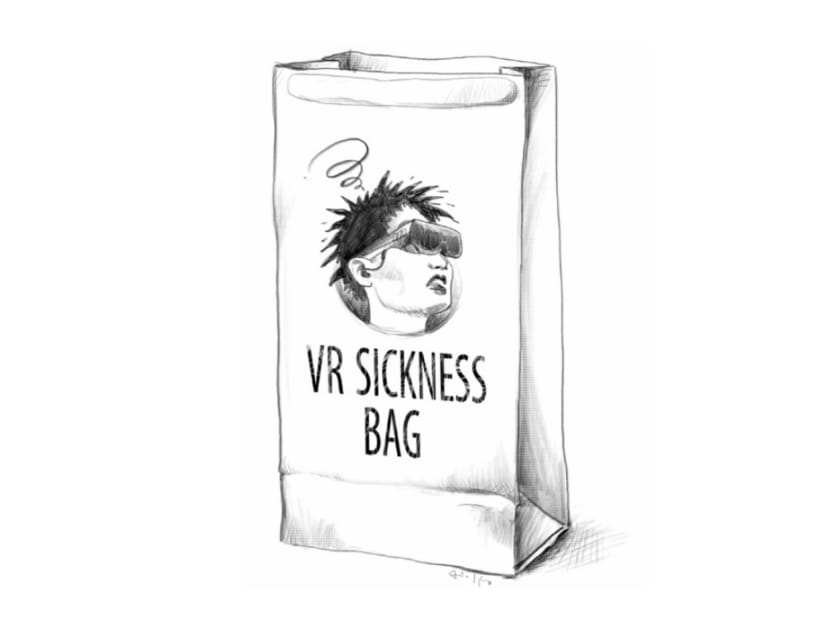A nauseating setback for the virtual reality industry
I probably do not need to tell you that really good virtual reality (VR) would be really cool. Your imagination will readily supply amazing things you could do with it, from training to video games.

I probably do not need to tell you that really good virtual reality (VR) would be really cool. Your imagination will readily supply amazing things you could do with it, from training to video games.
There is only one small problem standing between us and the immersive virtual future: Violent nausea.
Inside your head is an amazing system for keeping you upright. Your inner ears detect motion, and your brain coordinates that signal with your eyes to tell you where you are and how your body is moving through the environment.
However, if this signal goes haywire — if the message from your eyes does not match the message from your ears — your brain responds by instructing your gastrointestinal system to prepare for some vomiting.
That is what causes motion sickness (and why focusing on the horizon, which tells your brain you are moving, often helps). It is also a symptom of conditions such as vertigo.
As someone who suffers from a variant of vertigo, I have long been interested in this phenomenon, not just for personal reasons, but also because it is a bit of a mystery why this should occur — not just to us, but to other species, too.
Why does your brain react to a disconnect between ears and eyes by deciding it is time for some gastrointestinal distress? The reigning scientific theory, and one that I find extremely plausible, is that this is an evolutionary mechanism designed to protect us from neurotoxins.
Remember the first time you got drunk, and you noticed that there was a delay between moving your head and your vision catching up? That is neurotoxicity, and your body wants to protect you from it, so it tells your stomach to forcibly eject whatever funny thing you just ate.
Unfortunately, modern enclosed transportation often replicates the symptoms of neurotoxicity, which for people who are sensitive to motion sickness means vomiting up that perfectly harmless bowl of oatmeal you had for breakfast.
Sensitivity to this sort of sensory input problem varies — over time, as well as between people.
When I was a kid, I read for hours in moving cars. Now I have to be careful in movies with a lot of zooming; I had to take a long, slow walk home from a distant movie theatre after Iron Man triggered my vertigo.
That is not going to happen to most people. But the more immersive the stimulus, the bigger the disconnect between ears and eyes, which means that many less-sensitive people react to VR goggles the way I react to roller- coaster sequences.
Because of this problem, the industry has moved slowly. As one VR company’s chief technology officer told The New York Times, they are afraid of a nightmare scenario where people enjoy the store demo, take it home and start throwing up.
If people start to think of VR headsets as home vomitoriums, it could set the industry back a decade or more. So they are moving cautiously into the consumer market and warning developers against developing scenarios, such as roller-coaster sequences, that are particularly likely to induce motion sickness.
As The New York Times reports, however, at least one company, Valve, thinks it has cracked the motion- sickness problem, in part by better tracking the user’s real-world motions so that the headset’s visuals can track them. It says that no one who uses its headset has experienced motion sickness.
I am willing to bet that I could falsify that claim; I am sceptical that people who are very prone to motion sickness will be able to use VR anytime soon, unless the virtual environment is made so boring as to be pointless. But most people are not that delicate, and if VR takes off, we could be in for some amazing transformations.
VIRTUAL REALITY’s potential
Virtual reality is not just fun, as Wired magazine reports, it also has potential for helping people with phobias, pain management and various other sorts of healing applications.
With the help of robot “hands”, it could be used for remote performance of complex tasks, from repairing a computer to treating a patient. It could revolutionise communication, and maybe even travel. Those are just a few of the ways it could change the world for the good — though while we are on the topic, we should probably also mention the ways that it could change the world for the worse: By becoming a too-good substitute for Real Life.
If companies can finally conquer the motion sickness problem, those changes are coming, because VR is getting cheaper — thanks to, of all things, smartphones. Smartphones have driven a dramatic increase in demand for motion sensors, and as manufacturers have moved along the demand curve, the price has fallen sharply.
Wired suggests that a decent VR headset could fit in the budget of anyone who can afford an XBox. I, for one, will probably not be able to welcome our new virtual overlords. But though you will not be able to see me, I will be waving cheerily at the rest of you. BLOOMBERG
ABOUT THE AUTHOR:
Megan McArdle is a Bloomberg View columnist who writes on economics, business and public policy.






